(68163 products available)






























































































































































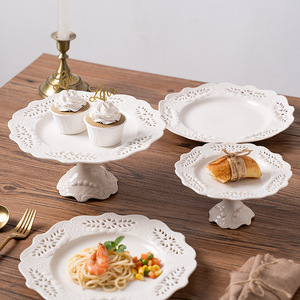







































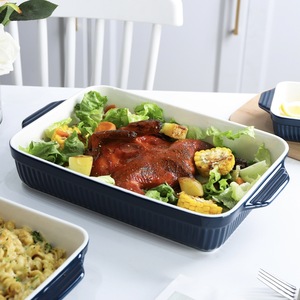
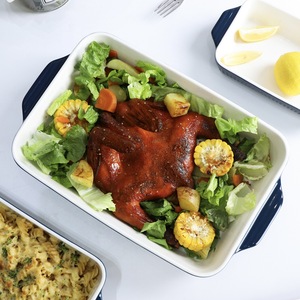
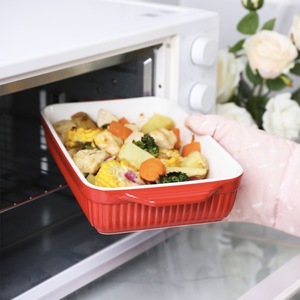
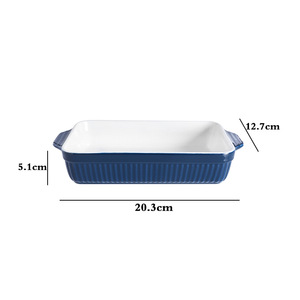






A ceramic tray is a flat container, often with raised edges, made from clay and other ceramic materials. It is molded and fired at a high temperature to achieve hardness and durability. Ceramic trays are versatile and can be used for serving, organizing, and decorating. Here are some of the common ceramic trays on the market:
Handmade ceramic trays:
Handmade ceramic trays are one-of-a-kind creations. Skilled artisans make them using traditional pottery techniques. They often have unique shapes, textures, and finishes. They add a special touch to any decor.
Glazed ceramic trays:
Glazed ceramic trays have a shiny coating that makes them waterproof. It makes the cleaning easy and keeps the food safe. The glaze comes in many colors and designs. It makes these trays both pretty and useful.
Unglazed ceramic trays:
These trays keep the food from slipping around. They use a rough, textured surface. They are great for serving snacks or holding things in a natural, earthy style.
Decorative ceramic trays:
Decorative ceramic trays are designed to be visually appealing. They often feature intricate patterns, bright colors, and artistic elements. They are used as centerpieces, wall art, or to display decorative items.
Textured ceramic trays:
Textured ceramic trays have raised patterns or rough surfaces. They provide grip and prevent items from sliding off. They are functional and add visual interest to a table or counter.
Modular ceramic trays:
These trays can be linked together. They can be stacked to save space or change the look. They are great for organizing and displaying things in different ways.
Engraved ceramic trays:
Engraved ceramic trays have designs carved into the ceramic. It creates a lasting, textured design. They often have a rustic or vintage look.
Ornamental ceramic trays:
Ornamental ceramic trays are decorated with plants, animals, and other natural features. They add a touch of nature to any space. They are perfect for holding flowers or candles.
Modern ceramic trays:
Modern ceramic trays have clean lines and simple designs. They focus on function and minimalism. They fit well in contemporary spaces and are great for serving or as a decorative accent.
A ceramic tray can be designed in many different ways. Some design aspects are crucial for making the ceramic trays aesthetically pleasing and functional. These are some of the design aspects of ceramic trays.
Shape:
The shapes of ceramic trays are numerous. The common forms are rectangular, round, and square. Some modern trays have unique geometric shapes, such as hexagons. They make the trays look different and attractive. The ceramic tray shapes are chosen according to the use they are put to and the decorations they are placed with. For example, square or rectangular trays are placed on dining tables. They can hold many items. Smaller items are carried on round or smaller square trays.
Color Options:
The color of the ceramic tray is an important design aspect. It influences how the tray looks and its decorative value. Ceramic trays have a wide range of colors, from soft, neutral tones to bright, bold colors. The color selection is done based on the intended use of the tray. It also depends on the decor it is placed with. For instance, white or cream-colored trays are used in modern and minimalist decors. Bright-colored trays are used as decorative items. They add splashes of color to the room.
Texture and Finish:
The ceramic tray's look and feel are influenced by its texture and finish. Some common finishes are glossy, matte, and textured. A glossy finish makes the tray look shiny and smooth. It is easy to clean and maintain. A matte finish gives a classic, elegant look. The tray with a matte finish has a better grip. Textured finishes make the trays look unique. They give a non-slip surface that is useful in many situations.
Edge Design:
The border of a ceramic tray is an important design aspect. It influences the aesthetics and functionality of the tray. Edges can be plain, sloped, or curved. Sloped edges make it easy to carry the tray. Curved edges prevent items from falling off the sides. Edge designs enhance the beauty of the tray. They increase its practicality by preventing spills.
Size and Dimensions:
The size and dimension of the ceramic tray are important design aspects. They influence the usability and functionality of the tray. Ceramic trays come in many sizes. Small trays are used to serve snacks. Large trays are used to hold many items or serve meals. The size of the tray is selected according to its use. For example, larger trays are needed in serving during parties.
From a functional point of view, ceramic trays can be used in many ways:
Moreover, ceramic trays also have various application scenarios:
Wholesale buyers need to consider these factors when selecting ceramic trays for their customer base.
Target Market Demand
Understand the preferences of the target customers. Know the trends in the ceramic tray market. Is there a demand for minimalist designs? Is there a demand for ornate, colorful, or hand-painted trays? Consider the customers' culture and lifestyle. Select trays that will appeal to the target customers.
Quality and Craftsmanship
Choose suppliers who provide ceramic trays with excellent craftsmanship. The trays should have smooth finishes and well-executed designs. Ensure that the materials used are durable and of high quality. Trays made with high-quality materials will have a lower return rate and will be more likely to satisfy customers.
Variety and Customization
Look for suppliers who offer a wide range of ceramic tray designs. The designs should have different sizes, colors, and patterns. Consider the possibility of customizing trays. Customization allows for adding the brand logo or specific design elements. It can help the trays stand out in the market and attract more customers.
Supplier Reputation and Reliability
Choose suppliers with a good reputation in the industry. They should deliver products as promised and on time. Check reviews and ratings from other buyers. Ensure that the supplier has a reliable quality assurance process. This will ensure that they deliver ceramic trays that meet the buyers' expectations.
Pricing and Profit Margin
Consider the pricing of the ceramic trays. Ensure that the price allows for a reasonable profit margin. Balance affordability and quality when choosing the trays. Avoid trays that are too cheap. They may have inferior materials and poor craftsmanship. Ensure that the trays are good enough to justify the price.
Logistics and Shipping
Consider the logistics of transporting the ceramic trays. Ceramic trays are fragile. Work with a supplier who has good packaging to reduce the risk of damage during shipping. Also, consider the shipping costs and delivery times. Choose a supplier who delivers trays quickly and cost-effectively.
Compliance and Safety Standards
Ensure that the ceramic trays meet relevant industry standards. They should comply with safety and health regulations. Check for certifications related to lead and phthalate content. Ensure that the trays are safe for serving food and using them in the home.
Q1: Are ceramic trays food safe?
A1: Yes, most ceramic trays are food-safe. They are made with food-grade glaze and materials. But, it is important to check the product details to make sure.
Q2: Can ceramic trays be used in the dishwasher and microwave?
A2: Ceramic trays can often go in the dishwasher and microwave. However, some may be very delicate or have special care needs. Always check the details first.
Q3: What styles do ceramic trays come in?
A3: Ceramic trays have many styles. These include classic, modern, rustic, and minimal looks. They also have different colors and designs to match any decor.
Q4: How can one clean a ceramic tray?
A4: To clean a ceramic tray, simply wash it with soap and water or put it in the dishwasher. For tough stains, a baking soda paste can help.
Q5: Are ceramic trays good for the environment?
A5: Ceramic trays are eco-friendly. Ceramic is a natural material, and these trays last a long time. This durability means less waste. Also, many ceramic trays use eco-friendly glazes and paints.